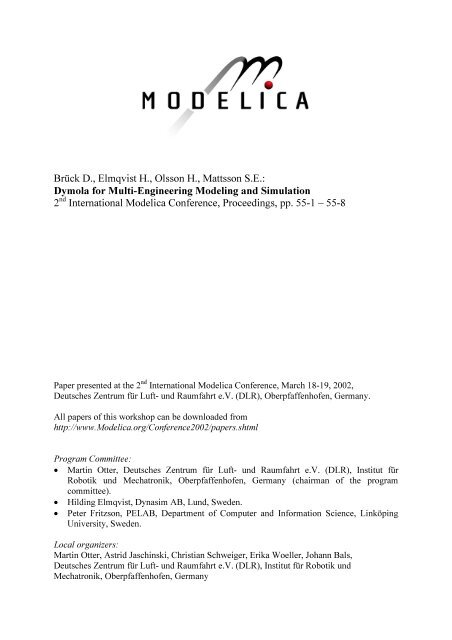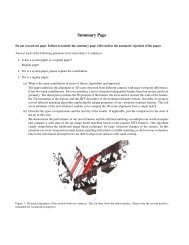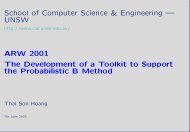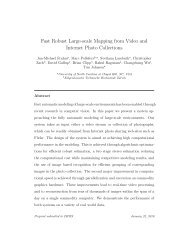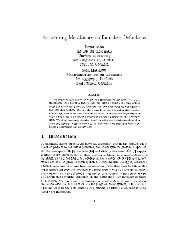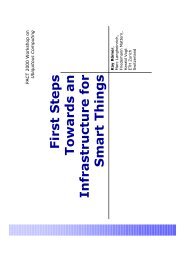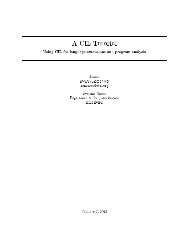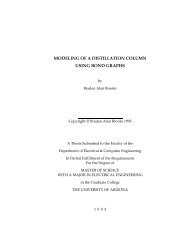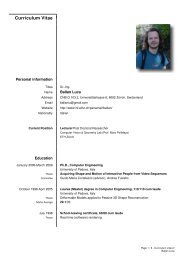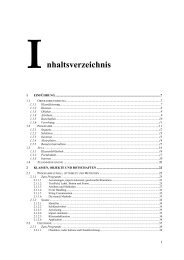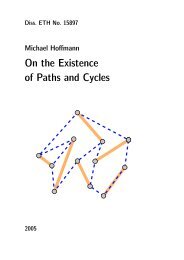Dymola for Multi-Engineering Modeling and Simulation
Dymola for Multi-Engineering Modeling and Simulation
Dymola for Multi-Engineering Modeling and Simulation
You also want an ePaper? Increase the reach of your titles
YUMPU automatically turns print PDFs into web optimized ePapers that Google loves.
%U FN ' (OPTYLVW + 2OVVRQ + 0DWWVVRQ 6 (<br />
'\PROD IRU 0XOWL (QJLQHHULQJ 0RGHOLQJ DQG 6LPXODWLRQ<br />
QG ,QWHUQDWLRQDO 0RGHOLFD &RQIHUHQFH 3URFHHGLQJV SS ±<br />
3DSHU SUHVHQWHG DW WKH �� ,QWHUQDWLRQDO 0RGHOLFD &RQIHUHQFH 0DUFK<br />
'HXWVFKHV =HQWUXP I U /XIW XQG 5DXPIDKUW H 9 '/5 2EHUSIDIIHQKRIHQ *HUPDQ\<br />
$OO SDSHUV RI WKLV ZRUNVKRS FDQ EH GRZQORDGHG IURP<br />
KWWS ZZZ 0RGHOLFD RUJ &RQIHUHQFH SDSHUV VKWPO<br />
3URJUDP &RPPLWWHH<br />
œ 0DUWLQ 2WWHU 'HXWVFKHV =HQWUXP I U /XIW XQG 5DXPIDKUW H 9 '/5 ,QVWLWXW I U<br />
5RERWLN XQG 0HFKDWURQLN 2EHUSIDIIHQKRIHQ *HUPDQ\ FKDLUPDQ RI WKH SURJUDP<br />
FRPPLWWHH<br />
œ +LOGLQJ (OPTYLVW '\QDVLP $% /XQG 6ZHGHQ<br />
œ 3HWHU )ULW]VRQ 3(/$% 'HSDUWPHQW RI &RPSXWHU DQG ,QIRUPDWLRQ 6FLHQFH /LQN|SLQJ<br />
8QLYHUVLW\ 6ZHGHQ<br />
/RFDO RUJDQL]HUV<br />
0DUWLQ 2WWHU $VWULG -DVFKLQVNL &KULVWLDQ 6FKZHLJHU (ULND :RHOOHU -RKDQQ %DOV<br />
'HXWVFKHV =HQWUXP I U /XIW XQG 5DXPIDKUW H 9 '/5 ,QVWLWXW I U 5RERWLN XQG<br />
0HFKDWURQLN 2EHUSIDIIHQKRIHQ *HUPDQ\
Brück D., Elmqvist H., Mattsson S.E., Olsson H., <strong>Dymola</strong> <strong>for</strong> <strong>Multi</strong>−<strong>Engineering</strong> <strong>Modeling</strong> <strong>and</strong> <strong>Simulation</strong><br />
<strong>Dymola</strong> <strong>for</strong> <strong>Multi</strong>-<strong>Engineering</strong> <strong>Modeling</strong> <strong>and</strong> <strong>Simulation</strong><br />
Abstract<br />
Dag Brück, Hilding Elmqvist, Sven Erik Mattsson <strong>and</strong> Hans Olsson<br />
Dynasim AB, Research Park Ideon, SE-223 70 Lund, Sweden<br />
E-mail: info@dynasim.se<br />
<strong>Dymola</strong> is an integrated environment <strong>for</strong> developing<br />
models in the Modelica language. The growing use of<br />
<strong>Dymola</strong> has over time increased the dem<strong>and</strong>s on the<br />
development environment. Requests <strong>for</strong> extension <strong>and</strong><br />
redesign originate from two sources: the need to<br />
simplify the use of <strong>Dymola</strong> to better support new <strong>and</strong><br />
inexperienced users, <strong>and</strong> the need to better support<br />
“power users” which model extremely large <strong>and</strong><br />
complex systems.<br />
Key areas in the development of <strong>Dymola</strong> are: a<br />
simplified <strong>and</strong> more coherent graphical user interface,<br />
browsing facilities <strong>for</strong> navigating large <strong>and</strong> complex<br />
systems, new experiment facilities <strong>for</strong> managing<br />
complex simulation tasks, distributed (parallel)<br />
simulation, <strong>and</strong> integrated version control to help<br />
manage model libraries <strong>and</strong> complete models.<br />
The paper describes the extensively redesigned<br />
<strong>Dymola</strong> 5, with an emphasis on new features compared<br />
to <strong>Dymola</strong> 4.<br />
Introduction<br />
<strong>Dymola</strong> is an integrated environment <strong>for</strong> developing<br />
models in the Modelica language [Modelica<br />
Association, 2002; Tiller, 2001], <strong>and</strong> a simulation<br />
environment <strong>for</strong> per<strong>for</strong>ming experiments. It is used<br />
since several years within major companies <strong>for</strong><br />
complex simulations. For example, <strong>Dymola</strong> has been<br />
used to simulate detailed models of complete vehicles<br />
including engine, transmission <strong>and</strong> chassis [Tiller et al.,<br />
2000].<br />
<strong>Dymola</strong> uses hierarchical object-oriented modeling to<br />
describe, in increasing detail, the systems, subsystems<br />
<strong>and</strong> components of a model. Reuse of modeling<br />
knowledge is a key issue, <strong>and</strong> is supported by use of<br />
libraries containing model classes <strong>and</strong> by the use of<br />
inheritance. Physical couplings are modeled by<br />
defining physical connectors <strong>and</strong> graphically<br />
connecting submodels.<br />
Model libraries are available <strong>for</strong> electronics, rotational,<br />
translational <strong>and</strong> 3D mechanics, thermodynamics,<br />
hydraulics <strong>and</strong> control systems. The libraries range<br />
from basic components to more specialized domains<br />
such as the power train library. Predefined libraries can<br />
be exp<strong>and</strong>ed with user-written model libraries.<br />
The growing use of <strong>Dymola</strong> has over time increased<br />
the dem<strong>and</strong>s on the development environment.<br />
Requests <strong>for</strong> extension <strong>and</strong> redesign originate from two<br />
sources:<br />
• The need to simplify the use of <strong>Dymola</strong> to better<br />
support new users <strong>and</strong> inexperienced users. This is of<br />
particular importance when <strong>Dymola</strong> is used <strong>for</strong><br />
teaching.<br />
• The need to better support “power users” which<br />
model extremely large <strong>and</strong> complex systems. In this<br />
case, the user needs significant support from the<br />
environment to h<strong>and</strong>le very large amounts of<br />
in<strong>for</strong>mation, to document complex systems, <strong>and</strong> to<br />
verify results. The development of large component<br />
libraries is a collaborative ef<strong>for</strong>t involving several<br />
people, which requires adequate tool support. Also,<br />
different software packages are used which underlines<br />
the need <strong>for</strong> in<strong>for</strong>mation exchange.<br />
Key areas in the development of <strong>Dymola</strong> are:<br />
• Simplified graphical user interface. In addition to<br />
better structuring, the use of modern GUI elements<br />
(help facilities, dockable windows etc.) makes it easier<br />
to use the program.<br />
• Browsing facilities <strong>for</strong> navigating large <strong>and</strong> complex<br />
systems. This includes class browsers <strong>for</strong> navigating<br />
component libraries <strong>and</strong> a new model browser <strong>for</strong><br />
navigating complex models.<br />
• New experiment facilities <strong>for</strong> managing complex<br />
simulation tasks. They h<strong>and</strong>le multiple parameter sets,<br />
models of different complexity, <strong>and</strong> tools <strong>for</strong> validating<br />
models.<br />
• Distributed simulation on several computers,<br />
allowing parallel simulation <strong>for</strong> tasks such as<br />
optimization.<br />
• Integrated version control to help manage model<br />
libraries <strong>and</strong> complete models. The user needs support<br />
<strong>for</strong> version control to store/retrieve models <strong>and</strong><br />
associated data, to compare versions of a model, plus<br />
mechanisms <strong>for</strong> documenting the evolution of models.<br />
The Modelica Association 55 − 1 Modelica 2002, March 18−19, 2002
<strong>Dymola</strong> <strong>for</strong> <strong>Multi</strong>−<strong>Engineering</strong> <strong>Modeling</strong> <strong>and</strong> <strong>Simulation</strong> Brück D., Elmqvist H., Mattsson S.E., Olsson H.,<br />
<strong>Modeling</strong><br />
<strong>Simulation</strong><br />
Visualization<br />
<strong>and</strong> Analysis<br />
User Models<br />
Modelica<br />
Libraries<br />
Optimization<br />
Distributed<br />
<strong>Simulation</strong><br />
Scripting<br />
Modelica<br />
C Functions<br />
LAPACK<br />
Figure 1. The <strong>Dymola</strong> architecture.<br />
<strong>Dymola</strong> architecture<br />
Experimental Data<br />
<strong>Dymola</strong> Program<br />
<strong>Dymola</strong> is an integrated environment <strong>for</strong> modeling <strong>and</strong><br />
simulation. Figure 1 describes the architecture <strong>and</strong><br />
connectivity of <strong>Dymola</strong> 5.<br />
At the modeling level, models are composed from<br />
library components (from the Modelica st<strong>and</strong>ard<br />
library, other free libraries, commercial <strong>and</strong> proprietary<br />
libraries), as well as models developed by the user.<br />
Models are either composed of other, more primitive,<br />
components, or described by equations at the lowest<br />
level. The equation-based nature of Modelica is<br />
essential <strong>for</strong> enabling truly reusable libraries.<br />
Measurement data <strong>and</strong> model parameters cover<br />
additional model aspects.<br />
Detailed model knowledge can be imported from CAD<br />
packages. Examples of such in<strong>for</strong>mation are mass <strong>and</strong><br />
inertia of 3D mechanical bodies, <strong>and</strong> the topology of a<br />
multibody system (bodies <strong>and</strong> joints). Graphical<br />
properties may be described in DXF <strong>and</strong> STL <strong>for</strong>mat.<br />
The icons of model components are defined either by<br />
drawing shapes in <strong>Dymola</strong>, or by importing graphics<br />
from other tools in common vector or bitmap <strong>for</strong>mats.<br />
At the simulation level, <strong>Dymola</strong> trans<strong>for</strong>ms a<br />
declarative, equation-based, model description into<br />
efficient simulation code. Advanced symbolic<br />
manipulation (computer algebra) is used to h<strong>and</strong>le very<br />
Editor<br />
Symbolic Kernel<br />
Experimentation<br />
Plot <strong>and</strong> Animation<br />
Reporting<br />
Model Parameters<br />
CAD (DXF, STL,<br />
topology, properties)<br />
External Graphics<br />
(vector, bitmap)<br />
dSPACE<br />
Simulink<br />
MATLAB<br />
Model doc. <strong>and</strong><br />
Experiment log (HTML,<br />
VRML, PNG, …)<br />
Modelica 2002, March 18−19, 2002 55 − 2 The Modelica Association<br />
HIL<br />
xPC<br />
large sets of equations. Efficient simulation, including<br />
realtime simulation of hydraulic systems, can only be<br />
achieved after extensive symbolic trans<strong>for</strong>mations of<br />
the equations [Elmqvist et al., 2002].<br />
<strong>Dymola</strong> provides a complete simulation environment,<br />
but can also export code <strong>for</strong> simulation in Simulink. In<br />
addition to the usual offline simulation, <strong>Dymola</strong> can<br />
generate code <strong>for</strong> specialized Hardware-in-the-Loop<br />
(HIL) systems, such as, dSPACE, xPC <strong>and</strong> others.<br />
Recent developments in <strong>Dymola</strong> 5 allow distributed<br />
(parallel) simulation on several computers in a<br />
network, <strong>for</strong> example to per<strong>for</strong>m parameter studies.<br />
There are facilities <strong>for</strong> optimization, also carried out<br />
with parallel simulation runs. Such experiments are<br />
controlled with a Modelica-based scripting language,<br />
which combines the expressive power of Modelica<br />
with access to external C libraries, e.g., LAPACK.<br />
The built-in plotting <strong>and</strong> animation features of <strong>Dymola</strong><br />
provide the basis <strong>for</strong> visualization <strong>and</strong> analysis of<br />
simulation data. Experiments are documented with logs<br />
of all operations in HTML <strong>for</strong>mat, including<br />
animations in VRML (Virtual Reality <strong>Modeling</strong><br />
Language) <strong>and</strong> images. Models <strong>and</strong> libraries are<br />
extensively documented in HTML automatically<br />
generated by <strong>Dymola</strong> from the models themselves.
Brück D., Elmqvist H., Mattsson S.E., Olsson H., <strong>Dymola</strong> <strong>for</strong> <strong>Multi</strong>−<strong>Engineering</strong> <strong>Modeling</strong> <strong>and</strong> <strong>Simulation</strong><br />
Figure 2. The model editor.<br />
Graphical user interface<br />
The graphical user interface has been extensively<br />
redesigned. In <strong>Dymola</strong> 5 emphasis has been put both<br />
on simplifying the task of building models <strong>for</strong> the<br />
novice user <strong>and</strong> on providing tools <strong>for</strong> building <strong>and</strong><br />
managing large <strong>and</strong> complex models developed by a<br />
collaborating team of engineers.<br />
Graphical editor<br />
Figure 2 shows a screen dump of the <strong>Dymola</strong> modeling<br />
environment. The top left tree browser shows the<br />
(Package) hierarchy of a library called SimpleCar<br />
[Tiller, 2001]. When I4_Engine is chosen different<br />
representations (icon <strong>and</strong> composition diagram) of the<br />
model I4_Engine are shown. The lower left tree<br />
browser, “Component <strong>and</strong> Extends hierarchy”, shows<br />
the hierarchical decomposition, <strong>for</strong> example, that the<br />
engine model contains crankshaft-inertia <strong>and</strong> the four<br />
cylinders: cylinder1, … cylinder4. A visual<br />
representation of that is shown in the Diagram in the<br />
middle. An Icon representation of the engine is shown<br />
at the top right. A The Documentation window is<br />
shown at the lower right. Such a documentation<br />
window contains HTML <strong>for</strong>matted in<strong>for</strong>mation, i.e.<br />
also graphics <strong>and</strong> links to other resources may be<br />
included.<br />
Editing of models at the fundamental level has been<br />
improved by syntax highlighting of the Modelica code,<br />
see Figure 3. Another convenience is that models can<br />
be dragged from the package browser into the text<br />
editor, which gives access to fundamental types in the<br />
Modelica library with no typing. Editing in the textual<br />
view is instantaneously represented in the graphical<br />
view.<br />
Figure 3. Model editor with syntax highlighting.<br />
The Icon representation can be created with a built-in<br />
graphical editor. It allows insertion of lines, rectangles,<br />
ellipses, polygons <strong>and</strong> text strings. Figure 4 shows the<br />
tool bar <strong>for</strong> the graphical editor.<br />
The Modelica Association 55 − 3 Modelica 2002, March 18−19, 2002
<strong>Dymola</strong> <strong>for</strong> <strong>Multi</strong>−<strong>Engineering</strong> <strong>Modeling</strong> <strong>and</strong> <strong>Simulation</strong> Brück D., Elmqvist H., Mattsson S.E., Olsson H.,<br />
Figure 4. Drawing tools.<br />
It is also possible to insert scalable bitmaps created in<br />
other tools like MS Paint <strong>and</strong> scalable vector graphics<br />
from the clipboard. Advanced graphics can thus be<br />
created in, <strong>for</strong> example, MS PowerPoint or MS Visio<br />
<strong>and</strong> inserted into <strong>Dymola</strong> as Icons or backgrounds <strong>for</strong><br />
the composition diagrams.<br />
The toolbar also contains controls <strong>for</strong> setting graphical<br />
attributes, e.g., <strong>for</strong>eground <strong>and</strong> background color, line<br />
style <strong>and</strong> fill pattern.<br />
As indicated above, <strong>Dymola</strong> 5 supports Modelica’s<br />
notion of different layers of in<strong>for</strong>mation:<br />
• Icon layer<br />
• Diagram layer<br />
• Documentation layer<br />
• Modelica text layer<br />
• Model dependencies layer (generated by <strong>Dymola</strong>)<br />
It should be noted that <strong>Dymola</strong> 5 allows several layers<br />
to be shown simultaneously.<br />
Figure 5. Navigation tools.<br />
Figure 5 shows the buttons of the navigation tool in<br />
<strong>Dymola</strong>. The first two buttons are used to navigate in<br />
the component hierarchy, similar to navigation with a<br />
web browser. The back arrow displays the previously<br />
visited component; the <strong>for</strong>ward arrow negates the<br />
backward move. The other buttons are used to display<br />
layers in the graphical editor<br />
Simplifications<br />
In response to user comments, a major design goal was<br />
to simplify the graphical user interface. The first step<br />
has been to reduce the number windows: both model<br />
editing <strong>and</strong> simulation is controlled from a single<br />
window, <strong>and</strong> plot/animation windows are not opened<br />
until a simulation has been per<strong>for</strong>med (or opened<br />
explicitly by the user). The design has been influenced<br />
by common paradigms, <strong>for</strong> example, the web-browser<br />
approach to navigation.<br />
The design of <strong>Dymola</strong> 5 more closely follows<br />
published guidelines [Microsoft, 1999], <strong>and</strong> has in<br />
general adopted more modern idioms compared to<br />
<strong>Dymola</strong> 4. Common operations are invoked by buttons<br />
in addition to menu comm<strong>and</strong>s. Dockable windows<br />
which either can be part of the main editor window,<br />
float on the desktop or be minimized, are used <strong>for</strong><br />
browsers <strong>and</strong> similar tools.<br />
The extended use of commonly used GUI elements<br />
(toolbars, dockable windows, “what’s this” help<br />
in<strong>for</strong>mation) makes <strong>Dymola</strong> consistent with other<br />
applications.<br />
Browsing<br />
The “Package hierarchy” browser shows the library<br />
structure <strong>and</strong> it is possible to drag a component model<br />
from the tree into a Diagram in order to add a<br />
component to a model, see Figure 6. The browser can<br />
either be docked to the editor window as shown in<br />
Figure 2, or be dragged onto the desktop.<br />
Figure 6. The package browser.<br />
The components of a library can also be viewed as<br />
icons in a separate library window, see Figure 7, from<br />
which components can be dragged.<br />
Figure 7. Library window.<br />
The hierarchical structure of a model is shown in the<br />
“Component <strong>and</strong> Extends hierarchy” browser. The toplevel<br />
components of an engine model are shown in<br />
Figure 8.<br />
Maneuvering in this hierarchical structure can be done<br />
by clicking in the tree which then changes the view to<br />
the selected model. It is also possible to point at an<br />
icon <strong>and</strong> “zoom-in” on the content, i.e. next abstraction<br />
layer.<br />
When a model is chosen in the package browser, it<br />
becomes the root model of the graphical editor. The<br />
root model is used in check, translate <strong>and</strong> simulate<br />
Modelica 2002, March 18−19, 2002 55 − 4 The Modelica Association
Brück D., Elmqvist H., Mattsson S.E., Olsson H., <strong>Dymola</strong> <strong>for</strong> <strong>Multi</strong>−<strong>Engineering</strong> <strong>Modeling</strong> <strong>and</strong> <strong>Simulation</strong><br />
Figure 8. The component browser.<br />
comm<strong>and</strong>s. Navigation into its component hierarchy<br />
allows inspection of model details, but does not change<br />
the root model or permit editing. This view is<br />
consistent with the common metaphor used in web<br />
browsers.<br />
<strong>Dymola</strong> 5 has search facilities, <strong>for</strong> example to search<br />
<strong>for</strong> models that mention particular keywords in the<br />
documentation. It may also be useful to find models<br />
with a component or a parameter with a known name.<br />
For advanced users, the biggest problem has been to<br />
organize the large amount of in<strong>for</strong>mation in complex<br />
models <strong>and</strong> extensive component libraries. The biggest<br />
improvement in <strong>Dymola</strong> 5 is the use of hierarchical<br />
browsers <strong>for</strong> navigating packages <strong>and</strong> models. The<br />
package browser is also the natural focal point <strong>for</strong><br />
copying/renaming of models <strong>and</strong> restructuring of<br />
packages.<br />
Advanced Modelica concepts, such as, replaceable<br />
classes, is given an intuitive user interface via the<br />
component browser. If a class is declared as<br />
replaceable, the actual class can be dragged from the<br />
package browser onto the replaceable class in the<br />
component browser. Other features that benefit from<br />
the new user interface are choices (a selection of<br />
replaceable classes) <strong>and</strong> arrays of components.<br />
Visualization in 3D<br />
The graphical editor represents a abstraction of the<br />
model, the object diagram. When building 3D<br />
mechanical systems, the user greatly benefits from the<br />
instantaneous 3D visualization available in <strong>Dymola</strong> 5.<br />
Parameters settings <strong>for</strong> e.g. the length of a bar can be<br />
visually checked in the animation window.<br />
Experimentation<br />
By “experimentation” we mean all the steps necessary<br />
to use a model in order to achieve useful results. That<br />
includes setting up model parameters <strong>and</strong> initial<br />
conditions, running simulations, analysis of simulation<br />
data, <strong>and</strong> report generation.<br />
Parameter values specific to the studied model have to<br />
be entered in a <strong>for</strong>m associated with a component, see<br />
Figure 9. Parameters <strong>and</strong> initial conditions can be set at<br />
three different abstraction levels:<br />
• The default values specified in the model of a<br />
component, when a reasonable default exists.<br />
• Parameter values that are specified in the modifier list<br />
of a specific component. For example, the crankshaft<br />
shift is different <strong>for</strong> each cylinder in an engine.<br />
• Model parameters which are specific <strong>for</strong> a given toplevel<br />
model. Such parameters are specified at the toplevel<br />
of the model, <strong>and</strong> then propagated through a<br />
hierarchical modifier.<br />
<strong>Dymola</strong> allows the user to set parameters <strong>and</strong> initial<br />
conditions at each of these levels, either through the<br />
model editor or while running simulations.<br />
Figure 9. Parameters <strong>for</strong> specification of details of<br />
the engine<br />
For visualization, <strong>Dymola</strong> offers plotting <strong>and</strong> 3D<br />
animation. Figure 10 shows a window with multiple<br />
Figure 10. Plot of car speed, engine RPM <strong>and</strong><br />
selected gear versus time.<br />
The Modelica Association 55 − 5 Modelica 2002, March 18−19, 2002
<strong>Dymola</strong> <strong>for</strong> <strong>Multi</strong>−<strong>Engineering</strong> <strong>Modeling</strong> <strong>and</strong> <strong>Simulation</strong> Brück D., Elmqvist H., Mattsson S.E., Olsson H.,<br />
plots of car speed, engine RPM <strong>and</strong> selected gear<br />
versus time during such an experiment. The car<br />
accelerated to 100 km/h in 6.66 seconds. Plots can be<br />
exported as PNG files <strong>for</strong> inclusion in session log or as<br />
vector graphics.<br />
Animation is provided by specialized visualization<br />
properties which are present in the mechanical libraries<br />
by default. These properties are calculated during<br />
simulation <strong>and</strong> then used to show 3D views in <strong>Dymola</strong>,<br />
as shown in Figure 11. It is also possible to export such<br />
animations in VRML <strong>for</strong>mat [VRML, 1997], which<br />
can be examined with special viewers or with plugins<br />
<strong>for</strong> web browsers.<br />
Figure 11. Animation of an automatic gearbox.<br />
<strong>Dymola</strong> 5 has powerful features <strong>for</strong> postprocessing of<br />
simulation results. It is possible to compare simulation<br />
results with experimental data. Data can be imported<br />
<strong>and</strong> exported to other programs like Matlab <strong>and</strong><br />
Microsoft Excel. There is a scripting language based on<br />
Modelica <strong>for</strong> automating design studies <strong>and</strong> analysis.<br />
Interfaces to subroutine packages such as LAPACK (or<br />
other libraries written in C or FORTRAN) enables<br />
advanced numerical calculations. The scripting<br />
language is also used <strong>for</strong> running parameter studies in a<br />
distributed environment (see below) <strong>and</strong> <strong>for</strong><br />
per<strong>for</strong>ming optimization.<br />
Figure 12. <strong>Dymola</strong> session window<br />
Automatic logging of design sessions including<br />
graphics is provided as HTML code <strong>for</strong> archiving <strong>and</strong><br />
sharing over the Internet, see Figure 12. A complete<br />
experiment report can be written by editing the session<br />
log.<br />
Distributed simulation<br />
During the design phase, hundreds or thous<strong>and</strong>s of<br />
simulations have to be per<strong>for</strong>med with different<br />
parameter sets. Optimization is used to determine<br />
parameters in the model by fitting simulation results to<br />
experimental data <strong>and</strong> to optimize the parameters of a<br />
design. It is a task that significantly benefits from<br />
parallel simulation. <strong>Dymola</strong> 5 can use many computers<br />
<strong>and</strong> automatically schedule simulations in parallel to<br />
shorten the design cycle.<br />
Figure 13 shows the <strong>Dymola</strong> monitoring window <strong>for</strong><br />
parallel simulations. It shows the status of each<br />
simulation run: the parameters used <strong>and</strong> optional<br />
criteria result. The <strong>Dymola</strong> scheduler assigns tasks to<br />
computers as they become available. When a<br />
simulation finishes, the next task is run on the freed<br />
computer. Transfers of the simulation code, input data<br />
(parameters <strong>and</strong> initial conditions) <strong>and</strong> results are fully<br />
automated.<br />
Figure 13. <strong>Dymola</strong> monitoring window <strong>for</strong> parallel<br />
simulations.<br />
During normal simulation on a single computer, a<br />
simulation is per<strong>for</strong>med through cooperation between<br />
the <strong>Dymola</strong> program <strong>and</strong> a separate simulation process.<br />
In a distributed environment, a third party, known as<br />
the simulation proxy, h<strong>and</strong>les data transfers between<br />
<strong>Dymola</strong> <strong>and</strong> the simulation task; the use of a proxy<br />
allows exactly the same simulation code to run locally<br />
<strong>and</strong> on another computer. As a special case, the<br />
“distributed” scheme can utilize multiple CPUs on one<br />
computer.<br />
Proxy<br />
Simulator<br />
TCP/IP<br />
<strong>Dymola</strong><br />
Proxy<br />
Simulator<br />
Modelica 2002, March 18−19, 2002 55 − 6 The Modelica Association<br />
DDE<br />
Figure 14. Architecture of distributed simulation.<br />
A proxy is started on each machine willing to act as<br />
“compute server”, see Figure 14. On receiving a<br />
connection via TCP/IP from a <strong>Dymola</strong> program, its<br />
first task is to help copy the simulation code <strong>and</strong> input<br />
files to a unique area on the server. It then relays<br />
parameter settings <strong>and</strong> comm<strong>and</strong>s from <strong>Dymola</strong>, <strong>and</strong>
Brück D., Elmqvist H., Mattsson S.E., Olsson H., <strong>Dymola</strong> <strong>for</strong> <strong>Multi</strong>−<strong>Engineering</strong> <strong>Modeling</strong> <strong>and</strong> <strong>Simulation</strong><br />
h<strong>and</strong>les data transfers from the simulation to <strong>Dymola</strong><br />
<strong>for</strong> online animation <strong>and</strong> plotting. The <strong>Dymola</strong><br />
program maintains a list of computers that may be<br />
asked to run simulations; the user can control this list<br />
by simple comm<strong>and</strong>s.<br />
This scheme <strong>for</strong> distributed simulation is designed <strong>for</strong><br />
cooperative sharing of resources <strong>and</strong> quite simple;<br />
security measures are limited. First, a computer can<br />
only be used as server after the proxy has been started.<br />
Second, the proxy runs as an unprivileged process,<br />
having only the capabilities of the user starting it. Load<br />
is limited because each proxy blocks requests while a<br />
simulation is running, but it is possible to start<br />
additional proxies to h<strong>and</strong>le multiple simulations (e.g.,<br />
if the computer has multiple CPUs). Ways to utilize<br />
existing system security features need to be further<br />
investigated.<br />
Collaborative development<br />
In developing model components <strong>for</strong> a complex system<br />
such as a vehicle, many different kinds of competence<br />
are needed. Experts in engines, transmissions <strong>and</strong><br />
chassis etc. are needed. Because several people are<br />
involved in the process, it becomes essential to break<br />
up or decompose the overall problem into modular<br />
units during development.<br />
The equation-based modeling supported by the<br />
Modelica language is fundamental in enabling true<br />
reuse of modeling knowledge <strong>and</strong> the practical use of<br />
model libraries. <strong>Dymola</strong> is able to trans<strong>for</strong>m equations<br />
of subcomponents as required by the structure of the<br />
system. Without the equation-based foundation, several<br />
variants of a single model are needed to h<strong>and</strong>le<br />
different computational causality. Even worse would<br />
have been that the user of a library is given the<br />
responsibility to analyze the computational causality of<br />
the system in order to pick the right variant.<br />
Inheritance is also important <strong>for</strong> supporting reuse.<br />
Model libraries may include partial models that<br />
describe common properties of a set of component<br />
types. Such a partial model is conveniently used as a<br />
base class to develop models <strong>for</strong> the individual types of<br />
the set by just adding a specific part that distinguish it<br />
from the others in the set. This approach makes it<br />
simpler to add new component models as well as<br />
simplifies maintenance since the common properties of<br />
the component types are described only once.<br />
Furthermore, as more people are involved in the<br />
process, the development is geographically <strong>and</strong><br />
chronologically distributed because it is natural to have<br />
centers with specific core-competencies. This implies<br />
that the modular units developed must be seamlessly<br />
integrated to solve the overall problem, <strong>and</strong> the<br />
partitioning should be able to reflect the organizational<br />
structure of the model development teams.<br />
In order to increase quality <strong>and</strong> reduce development<br />
time, tools should be made available to<br />
• Provide a structure <strong>for</strong> organizing, storing <strong>and</strong><br />
retrieving in<strong>for</strong>mation (models, documentation,<br />
experiment data).<br />
• Support the exchange of in<strong>for</strong>mation <strong>and</strong> simplify<br />
reuse of models throughout the organization.<br />
• Ensure that correct in<strong>for</strong>mation is available to each<br />
user (versions of libraries, corresponding experiments).<br />
A version control system provides means to track<br />
changes to a set of files. A “commit” operation<br />
associates a developer <strong>and</strong> documentation with each<br />
change to the common storage of files. The Modelica<br />
text of two versions can be compared, <strong>and</strong> it is possible<br />
to back up to any previous version.<br />
The underlying version control system must be able to<br />
support multiple concurrent developers working on the<br />
same set of models. Extensive locking of files is<br />
undesirable in a collaborative environment, <strong>and</strong> more<br />
recent tools also support concurrent development of<br />
closely related parts (with appropriate safety nets). A<br />
single physical person may have multiple roles in the<br />
development or use of the library.<br />
Tracability is essential <strong>for</strong> maintaining quality over<br />
time. Tool en<strong>for</strong>cement to document modifications<br />
be<strong>for</strong>e they become publicly available gives the<br />
opportunity to review changes <strong>and</strong> improves quality.<br />
The development history <strong>and</strong> documentation of<br />
changes may also be needed <strong>for</strong> tracing model<br />
incompatibilities, <strong>for</strong> example.<br />
Model testing should be integrated with model<br />
development, which implies that the version control<br />
system must be able to h<strong>and</strong>le test scripts, support<br />
utilities <strong>and</strong> binary test data. Regression testing, where<br />
models are simulated <strong>and</strong> compared with known good<br />
simulation results, is very powerful in detecting<br />
involuntary changes to model libraries. A failed<br />
regression test may cause either a change of a model,<br />
or the revision of the test itself.<br />
<strong>Multi</strong>ple libraries are often used together. In this case,<br />
version compatibility across libraries becomes<br />
essential. It must be possible to “tag” releases of<br />
multiple libraries to indicate compatibility at the<br />
project level.<br />
<strong>Dymola</strong> will support storing, retrieving, etc. of models<br />
in version control systems such as CVS (Concurrent<br />
Version System) [CVS]. We have deliberately chosen<br />
to build on existing version control systems, which<br />
offers greater flexibility <strong>and</strong> better integration than a<br />
proprietary system. Because of the textual<br />
representation of models in the Modelica language,<br />
existing text-based tools can be used, <strong>for</strong> example, to<br />
compare versions. To browse changes in large systems,<br />
support in the graphical environment of <strong>Dymola</strong> is<br />
needed.<br />
The use of public libraries has increased in industry<br />
over several years. More recent is “open source<br />
The Modelica Association 55 − 7 Modelica 2002, March 18−19, 2002
<strong>Dymola</strong> <strong>for</strong> <strong>Multi</strong>−<strong>Engineering</strong> <strong>Modeling</strong> <strong>and</strong> <strong>Simulation</strong> Brück D., Elmqvist H., Mattsson S.E., Olsson H.,<br />
development”, which can be described as the loosely<br />
organized development (typically of software) by<br />
several geographically separated parties. Public<br />
websites, such as SourceForge, support Open Source<br />
development with web-based tools <strong>and</strong> CVS. The<br />
Modelica St<strong>and</strong>ard Library is maintained as a project at<br />
SourceForge.<br />
Library protection<br />
There are many closed simulation packages on the<br />
market where you are not able to see what model is<br />
used. <strong>Modeling</strong> is an art in the sense of describing the<br />
relevant aspects of the object under observation. It is<br />
thus very important to be able to see what assumptions<br />
<strong>and</strong> approximation that the author of a model made.<br />
<strong>Dymola</strong> is open to view all <strong>and</strong> possibly modify the<br />
details by showing of the Modelica code. However, if a<br />
company want to protect proprietary in<strong>for</strong>mation when<br />
shipping models, <strong>Dymola</strong> will support encryption of<br />
model details.<br />
A protected library typically consists of parts that are<br />
open, <strong>and</strong> other parts that need protection. Protected<br />
parts may require different degree of in<strong>for</strong>mation<br />
hiding, <strong>for</strong> example<br />
• Preventing unauthorized modification of models (but<br />
viewing is unrestricted).<br />
• Parameters <strong>and</strong> documentation are visible, but model<br />
structure <strong>and</strong> equations are protected.<br />
• The model is regarded as a “black box”. Only model<br />
connectors <strong>and</strong> the icon are available to the user.<br />
The other aspect of library protection is to ensure<br />
authorized use. In this case, any use of the library is<br />
controlled by options in a license file. A special license<br />
is also needed to make protected libraries in order to<br />
prevent unauthorized distribution.<br />
Acknowledgements<br />
The authors would like to thanks all users of <strong>Dymola</strong>,<br />
who through their suggestion have directly influenced<br />
the development of <strong>Dymola</strong>.<br />
This work was in parts supported by the European<br />
Commission under contract IST-199-11979 with<br />
Dynasim AB under the In<strong>for</strong>mation Societies<br />
Technology as the project entitled “Real-time<br />
simulation <strong>for</strong> design of multi-physics systems”.<br />
References<br />
CVS: http://www.cvshome.org/<br />
Elmqvist, Hilding, Sven Erik Mattsson <strong>and</strong> Hans<br />
Olsson (2002): “New Methods <strong>for</strong> Hardware-in-theloop<br />
<strong>Simulation</strong> of Stiff Models”, Modelica 2002,<br />
Modelica Association.<br />
Microsoft (1999): Microsoft Windows User<br />
Experience, Microsoft Press.<br />
Modelica Association (2002): “Modelica — A Unified<br />
Object-Oriented Language <strong>for</strong> Physical Systems<br />
<strong>Modeling</strong>”, Language specification version 2.0,<br />
January 30, 2002.<br />
Tiller, Michael, Paul Bowles, Hilding Elmqvist, Dag<br />
Brück, Sven Erik Mattsson, Andreas Möller <strong>and</strong> Hans<br />
Olsson (2000): “Detailed Vehicle Powertrain <strong>Modeling</strong><br />
in Modelica”, Modelica 2000, Modelica Association.<br />
Tiller, Michael (2001): Introduction to Physical<br />
<strong>Modeling</strong> with Modelica, Kluwer Academic Publ.<br />
VRML (1997): “In<strong>for</strong>mation technology — Computer<br />
graphics <strong>and</strong> image processing — The Virtual Reality<br />
<strong>Modeling</strong> Language (VRML) — Part 1: Functional<br />
specification <strong>and</strong> UTF-8 encoding”, International<br />
St<strong>and</strong>ard ISO/IEC 14772-1:1997.<br />
Modelica 2002, March 18−19, 2002 55 − 8 The Modelica Association


